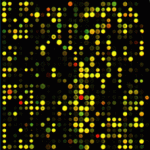Genomics
|
17 april 2012 05:48:34 |
| A comparative study of nemertean complete mitochondrial genomes, including two new ones for Nectonemertes cf. mirabilis and Zygeupolia rubens, may elucidate the fundamental pattern for the phylum Nemertea (BMC Genomics) |
|
Tweet Background:
The mitochondrial genome is important for studying genome evolution as well as reconstructing the phylogeny of organisms. Complete mitochondrial genome sequences have been reported for more than 2200 metazoans, mainly vertebrates and arthropods. To date, from a total of about 1275 described nemertean species, only three complete and two partial mitochondrial DNA sequences from nemerteans have been published. Here, we report the entire mitochondrial genomes for two more nemertean species: Nectonemertes cf. mirabilis and Zygeupolia rubens.
Results:
The sizes of the entire mitochondrial genomes are 15365 bp for N. cf. mirabilis and 15513 bp for Z. rubens. Each circular genome contains 37 genes and an AT-rich non-coding region, and overall nucleotide composition is AT-rich. In both species, there is significant strand asymmetry in the distribution of nucleotides, with the coding strand being richer in T than A and in G than C. The AT-rich non-coding regions of the two genomes have some repeat sequences and stem-loop structures, both of which may be associated with the initiation of replication or transcription. The 22 tRNAs show variable substitution patterns in nemerteans, with higher sequence conservation in genes located on the L strand. Gene arrangement of N. cf. mirabilis is identical to that of Paranemertes cf. peregrina, both of which are Hoplonemertea, while that of Z. rubens is the same as in Lineus viridis, both of which are Heteronemertea. Comparison of the gene arrangements and phylogenomic analysis based on concatenated nucleotide sequences of the 12 mitochondrial protein-coding genes revealed that species with closer relationships share more identical gene blocks.
Conclusion:
The two new mitochondrial genomes share many features, including gene contents, with other known nemertean mitochondrial genomes. The tRNA families display a composite substitution pathway. Gene order comparison to the proposed ground pattern of Bilateria and some lophotrochozoans suggests that the nemertean ancestral mitochondrial gene order most closely resembles the heteronemertean type. Phylogenetic analysis proposes a sister-group relationship between Hetero- and Hoplonemertea, which supports one of two recent alternative hypotheses of nemertean phylogeny. |
| 116 viewsCategory: Genomics |
 Transcriptomic and Proteomic Analyses of Desulfovibrio vulgaris Biofilms: Carbon and Energy Flow Contribute to the Distinct Biofilm Growth State (BMC Genomics) Transcriptomic and Proteomic Analyses of Desulfovibrio vulgaris Biofilms: Carbon and Energy Flow Contribute to the Distinct Biofilm Growth State (BMC Genomics)A transcriptome map of perennial ryegrass (Lolium perenne L.) (BMC Genomics) 
|
| blog comments powered by Disqus |
MyJournals.org
The latest issues of all your favorite science journals on one page
The latest issues of all your favorite science journals on one page



